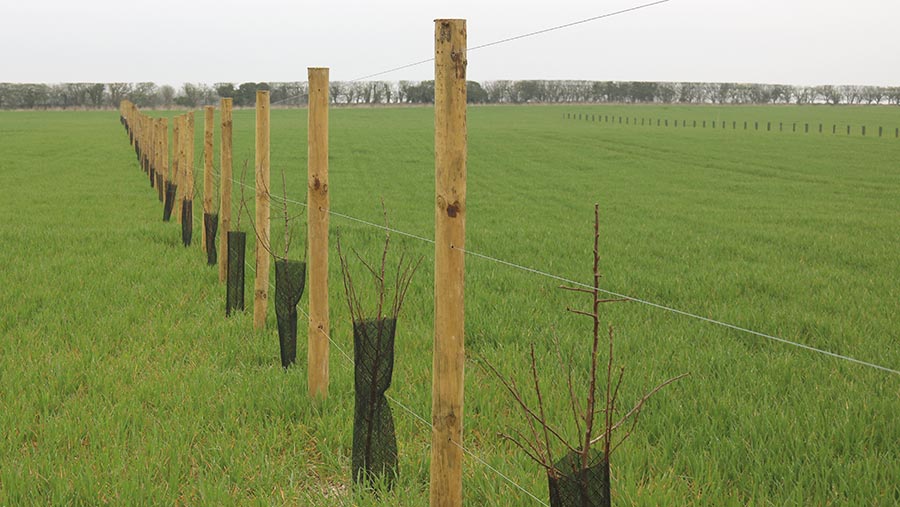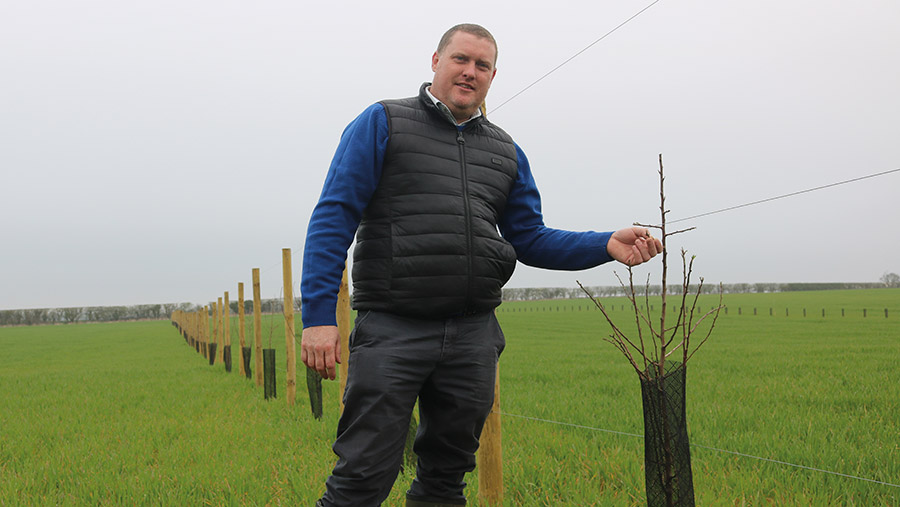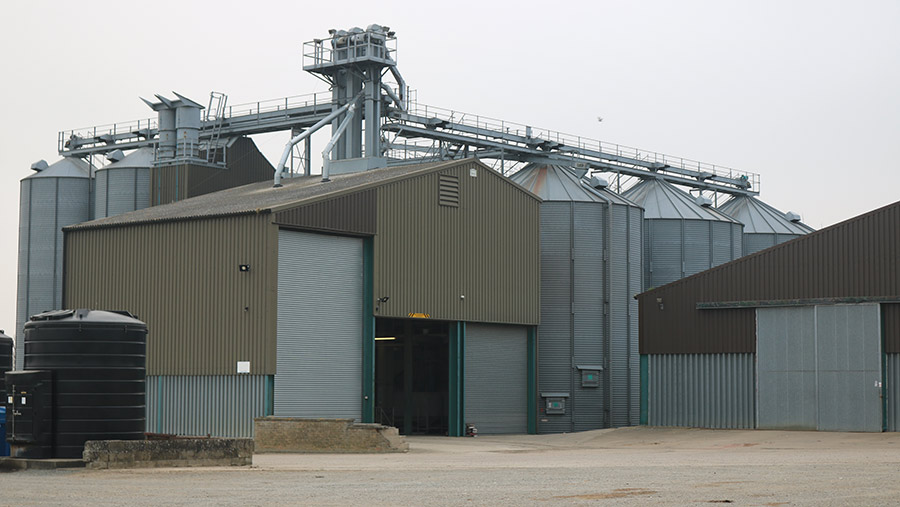How agroforestry venture adds value to natural capital
 © Tom Allen-Stevens
© Tom Allen-Stevens Line after line of newly planted trees stretch across a 13ha field on the outskirts of the village of Barton Bendish in west Norfolk.
The trees are part of an agroforestry venture at Hill Farm – one of four large-scale farms operated by Albanwise Farming in Norfolk and Yorkshire.
It is one of 16 Transition Farms whose journey Farmers Weekly is following as the farm business seeks to secure itself a more sustainable future.
See also: What farmers can do to unlock the value of natural capital
Farm Facts: Hill Farm, Barton Bendish, Norfolk
- Farm size 2,650ha (part of Albanwise Farming’s 12,000ha across Norfolk and Yorkshire)
- Enterprises All arable – 2,400ha combinable crops: winter wheat, winter and spring barley, oilseed rape, winter rye, grain maize and spring beans; sugar beet; forage maize for Future Biogas AD plant at Swaffham; vining peas; the rest in woodland, pasture and stewardship
- Annual rainfall 660mm
- Soil Light chalk and sandy to heavier loams
In rows 40m apart, the lines of trees here will soon include 4m-wide wildflower strips, leaving 36m between to match the tramlines.
“These are almond trees – a bit of an experiment, really,” explains Mike Edwards, as he inspects the young saplings, which are just pushing out their first leaves.
“We have a mixture of fruit and nut and some boundary trees. So there’s also walnut, hazel, sweet chestnut, mulberry, pears, apples, hornbeam, beech, oak and small-leaf lime.”
Natural capital
“It took a bit of juggling in this field to align the rows of trees with the electricity poles,” says Mr Edwards, who is a director of Albanwise Environment.
The capital cost of planting the trees was covered by Defra’s Shared Outcome Fund – Trees Outside Woodlands project, via Norfolk County Council.
“We’re responsible for the maintenance, and I guess we’ll harvest the fruit and nuts,” he says.
But the real value in the trees may lie not in the fruits they bear, nor in their aesthetics, but in their natural capital.
This includes the carbon dioxide they sequester and the wildlife they support – with matching lines of trees in a neighbouring field, encompassing some 20ha in total.
To find out how much these benefits are worth, Albanwise is assessing the natural capital across the whole of Hill Farm – the carbon footprint of the business, along with its biodiversity value and water quality.
Measuring benefits
To do this, it is using Sandy – a software package developed by Trinity AgTech, which uses scientific modelling to assess natural capital on a field-by-field basis.
Cropping records, generated by Gatekeeper, have already been uploaded into Sandy. So too has information on woodland, hedgerows and other environmental features.
“The first step is to work out our baseline, establish our main sources of emissions and make a plan for reaching net zero – we want to get there by 2030,” says Mr Edwards.
“But we also have an eye on the carbon market, and how that can supplement the farm income. And I’m particularly keen to know the farm’s biodiversity value.”
On the way to another field, he points out the boundary trees – a striking feature of the estate. “Sadly, we’ve lost a lot through ash dieback, and are currently replacing them as we restore old hedgerows,” he says.
He stops by one hedgerow that has recently been laid, its new growth now greening over the slanted liggers.
Countryside Stewardship funding
“This was originally planted with a stewardship grant, over a decade ago, and we received additional grant funding to lay it.” Boundary trees are planted in 1.6m tubes and are well-protected by the hedge.
The estate has 92km of hedgerow and in the past four years has planted more than 7km of new hedges with about 1,000 boundary trees.
Its Entry Level and Higher Level Stewardship contracts ended in February, and Mr Edwards is in the throes of stepping up to a Higher-Tier Countryside Stewardship Agreement, planned to start next January.
“We have been asked by Natural England to join the Insect Link project to support the rare Grizzled Skipper butterfly, so intend to make a 24m wildlife corridor through the farm for it,” Mr Edwards says.
“This will be a series of AB8 flower-rich margins and AB11 cultivated areas for arable plants.”

Mike Edwards © Tom Allen-Stevens
Whole-farm strategy
But plans to enhance the natural capital at Hill Farm aren’t restricted to field edges. They also involves the farm business itself – overseen by farm manager Duncan Blyth and assistant James Sedgwick.
All straw goes off the farm to neighbours in a straw-for-muck deal, which enhances soil organic matter.
This, and about 16,000 cu m of digestate from the AD plant, form early season nutrition and reduce dependence on bought-in synthetic fertiliser.
The farm is also moving to a mandate across the business that every hectare of stubble gets a cover crop if it is not immediately drilled up.
This may be fodder radish with barley mixed in, grazed off by sheep from two local graziers, while phacelia and black oats go in ahead of vining peas.
Cultivations are “as little as possible”, with a 6m Sky EasyDrill used direct on about 200ha of the farm’s heavier ground.
A Vaderstad Rapid remains the main establishment tool, while the plough comes out only for second cereals and after sugar beet.
Our tour of the farm ends on some land that lies next to the village, with 23ha destined for arable reversion.
“These are smallish, awkward fields, and probably among the least profitable,” Mr Edwards says.
“They’ll be put to permanent pasture and we have plans to add ponds and scrapes to attract a wider range of species, so it’ll be interesting to see what their natural capital value will be.”
Back in the farm office, he opens the laptop and joins a Zoom call with Alasdair Sykes and Milad Toolabi from Trinity AgTech to discuss the natural assets and where the opportunities may lie.
Net carbon balance
The carbon figures have not been finalised, but Dr Sykes gives his initial impression of the sequestration value of the features on the farm, starting with the agroforestry.
“This is a happy medium between production and trees, and not insignificant in terms of what it can capture,” he says.
“The agroforestry module in Sandy generally indicates 1-3t/ha of carbon dioxide, while the emissions for a typical arable field are around 2t/ha.
“It doesn’t guarantee net zero, but certainly helps on a field basis. Agroforestry is also a highly tradable form of carbon, and both the trees and the wildflower strips boost the biodiversity score,” he adds.
That’s good news, but with only 20ha, and no plans to extend the venture, the overall impact will not be great. So what about the 92km of hedgerows, asks Mr Edwards.
“These have good potential, but much depends on their management,” advises Dr Sykes.
“Laying or thickening a hedge that’s in poor condition adds significantly to its carbon value, but still doesn’t sequester as much carbon as you might hope, given the visual impact – in total they may offset emissions from approximately 10ha of arable cropping and perhaps 15ha with good management.
“They have considerable landscape and biodiversity value, however.”

© Tom Allen-Stevens
It is a similar picture for the rest of the woodland. There are plans for a further 25ha around the agroforestry fields which will, along with other woodland, all sequester carbon.
The boundary trees each contribute a little, with their value in landscape terms far higher. But for all their good management, it is clear the farm’s trees and hedgerows are nowhere near enough to offset the arable emissions.
Dr Sykes says: “Synthetic fertiliser contributes the most here, both in terms of Scope 3 emissions – relating mainly to its manufacture – and the release of nitrous oxide from fields following application.
One kilogram of nitrous oxide released into the atmosphere is equivalent to about 298kg of carbon dioxide.
“The manure and digestate represent the best material you can apply from a carbon perspective.
“They reduce reliance on synthetic fertiliser, cutting nitrous oxide emissions by up to two thirds, and help to increase soil organic matter (SOM).
“There’s huge potential to do this in arable soils which can sequester large amounts of carbon.”
The reduced tillage will also help, he adds – ploughing tends to release carbon dioxide and reduces SOM. But what about the arable reversion?
“Reverting to permanent pasture can increase carbon stocks in those fields by up to 40% – that’s huge,” notes Dr Sykes.
“But be careful of leakage – arable production displaced from Hill Farm will have to be sourced from elsewhere, which may result in higher emissions per kilogram of food produced.
“This would be taken into account if you choose to trade carbon.”
What is Sandy?
Developed by software specialist Trinity AgTech, Sandy is a digital assistant that helps farmers take control of the natural capital assets in their care.
It does this by calculating, evaluating and measuring carbon emissions and sequestration, biodiversity and water stewardship of all the main farming enterprises, including woodland and glasshouse production.
Farmers can then plan using scenarios to understand which actions are best to improve environmental performance and generate carbon credits.
Trinity Natural Capital Markets is a platform that offers additional biodiversity and water protection co-benefits, and biodiversity tokens as these markets develop.
Biodiversity
Sandy scores the biodiversity of land parcels on a scale of 1-5, based mainly on records of their use and management.
This follows an established scientific process informed by peer-reviewed studies, notes Dr Sykes.
“We look at five aspects, scoring for each field and the farm as a whole: farmland wildlife, pollinators, natural enemies, conservation score and soil biodiversity.”
Subject to what the final figures reveal, he is expecting strong results. “The network of hedgerows with boundary trees and 4m margins will already deliver high scores.
Plans to increase these to 6m and add a new wildlife corridor will create additional benefits.
The arable reversion area and agroforestry in particular have a high wildlife value and will boost scores once established.
“In the fields, the cover crop policy is excellent for all biodiversity metrics, while manure applications, combined with reduced tillage, build soil biodiversity.”
This is good news for Mr Edwards, who explains that costs of all the environmental measures the farm undertakes are generally covered by grant funding and stewardship payments.
So what about the prospect of additional payments on the private market? He sees an opportunity in fulfilling the new biodiversity net gain requirements for housing developments.
Dr Sykes agrees, but strikes a note of caution. “Buyers will be looking for additionality, so voluntary measures you are implementing for which you’re not fully compensated by public grant-funding.
Auditors will also be checking they will bring a genuine net gain,” he says.
“However, the prices paid for carbon are hugely variable and you can attract a premium through platforms such as Trinity Natural Capital Markets for carbon with co-benefits. Agroforestry in particular does well here.”
Nitrate leaching
Dr Toolabi explains that Sandy uses field records of fertiliser applications combined with historic weather and soil type and topography data to accurately assess this metric.
“While synthetic fertiliser is instantly available to the crop, it also leaches easily. How much is lost depends on timing and also the amount applied, and can be as much as 30%.
“With the current price of fertiliser, it’s not just environmental damage that’s the concern.
“Organic manures, if applied within guidelines, release N gradually. They also increase SOM, improving a soil’s ability to retain nutrients.
“Cover crops help to capture excess nutrients, especially in that post-harvest to late autumn window, which is when a lot of leaching to groundwater occurs.
“They also build SOM and make the N available gradually to the following cash crop as the cover dies back,” he advises.
“Hill Farm is putting in place all the right measures to reduce leaching. As well as providing historic information, Sandy can advise on when and how much fertiliser to apply to reduce leaching going forward.
“Generally, little and often is the best approach.”
Nitrogen uptake efficiency
With fertiliser prices soaring, this is one metric Albanwise is keen to improve across the business.
Dr Toolabi explains it runs in tandem with nitrate leaching and measures the ratio of nitrogen taken up by the crop to the total nitrogen available in the soil.
“Applying small amounts of fertiliser frequently according to crop need is again the best way to improve this,” he says.
“Variable-rate application, leaf-tissue and soil testing to assess reserves and crop need through the season also help. A nutrient analysis of manure and digestate applied is important to tailor applications and therefore improve nitrogen uptake efficiency.” n
Conclusions
“For Albanwise, this is very much a journey we’ve been on for some time,” says Mr Edwards.
“As a business we believe both in land-sparing – setting areas aside for nature – as well as land-sharing, ensuring we improve the environmental performance of the arable fields.
“But we must strike the right balance – produce optimal yields sustainably.
It’s really interesting to see how the software puts things into perspective from both an environmental and financial point of view,” he says.
He is buoyed by what he now knows of the prospects for the natural assets at Hill Farm, especially the multiple benefits from the agroforestry, arable reversion and measures to improve SOM.
“The interest in natural capital is now really accelerating, and it’s clear that those who have the data that demonstrate what they have will be the ones who will be able to make the most of the opportunities.
“As for trading carbon and biodiversity net gain, we may be holding back on plans for the moment to see how the market develops.
But we now have the tools to measure our natural capital, and can use these to understand what we have and then how we want to use them,” he concludes.
